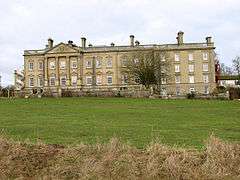Riddlesworth Hall School
| Riddlesworth Hall | |
|---|---|
 | |
| Alternative names | Riddlesworth Hall School |
| General information | |
| Type | Manor |
| Town or city | Riddlesworth |
| Country | England |
| Completed | 1792 |
| Client | Silvanus Bevan III |
| Design and construction | |
| Architect | Thomas Leverton |
Riddlesworth Hall School is a former country house. It now serves as a boarding school. It is located in Riddlesworth, Norfolk, England.
History
It was acquired by Silvanus Bevan III (1743–1830) in 1792.[1][2]
It later became the seat of the Compton-Thornhill baronets, including Sir Thomas Thornhill, 1st Baronet (1837-1900) and Sir Anthony John Compton-Thornhill, 2nd Baronet (1868–1949). The second baronet had no heirs and the hall was converted for use as a school.[1][3]
Architecture
It was designed by architect Thomas Leverton (1743-1824) as a Georgian style three-storey manor house in 1792.[1][3] It is surrounded by 12 hectares of parkland.[3]
It was listed by English Heritage as a Grade II building on July 21, 1951.[1]
Riddlesworth Hall Preparatory School
| Established | 1946 |
|---|---|
| Type |
Preparatory school Day & Boarding |
| Religion | Church of England |
| Headmaster | Paul Cochrane |
| Location |
Hall Lane Diss Norfolk IP22 2TA United Kingdom |
| DfE number | 926/8600 |
| Gender | Coeducational |
| Ages | 2–13 |
| Houses | 4 |
| Website |
riddlesworthhall |
In 1946, Riddlesworth Hall School was established as a predominantly girls' school but now caters to both boys and girls aged 2 to 13.[4] In October 2015 it was announced that Riddlesworth joined the Confucius International Education Group, which runs several international schools in China. Riddlesworth was rebranded Confucius International School-Riddlesworth Hall (CISRH) as a result.[5]
Boarding
Full and part-time boarding is available for children from age 7. Enrolment is intentionally kept small to maintain a "family" atmosphere amongst pupils and teachers. The Headmaster and his family live on campus and personally take responsibility for pastoral care of boarders.[6] Riddlesworth also specially caters to children of British Armed Forces personnel and offers escorted travel to and from airports for families posted abroad.[7]
Houses
Pupils are allocated to four houses, which are named after prominent British women. Points are awarded for "achievement, effort, behavior and generosity of spirit".[8]
| House | Colour | Namesake |
|---|---|---|
| Aylward | Gladys Aylward, missionary | |
| Cavell | Edith Cavell, nurse | |
| Fry | Elizabeth Fry, reformer | |
| Nightingale | Florence Nightingale, nurse |
Notable former pupils
- Diana, Princess of Wales[3][9]
- Lady Sarah McCorquodale, sister of Princess Diana
- Jane Fellowes, Baroness Fellowes
References
- 1 2 3 4 British Listed Buildings
- ↑ The Regency Town House: The Bevans
- 1 2 3 4 Select English Archived September 27, 2013, at the Wayback Machine.
- ↑ Department of Education
- ↑ Ward, Zach (1 October 2015). ""Change in direction" for Riddlesworth Hall Preparatory School under new Chinese ownership". Diss Express.
- ↑ Boarding
- ↑ Service Families
- ↑ Houses
- ↑ "The House of Windsor from 1952 — Diana, Princess of Wales: Childhood and teenage years". royal.gov.uk. Archived from the original on December 4, 2010.
External links
- School Profile at the Independent Schools Council website
- Independent Schools Inspectorate Inspection Reports
Coordinates: 52°23′39″N 0°53′16″E / 52.3943°N 0.8877°E
